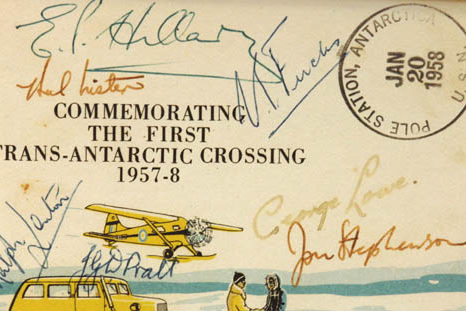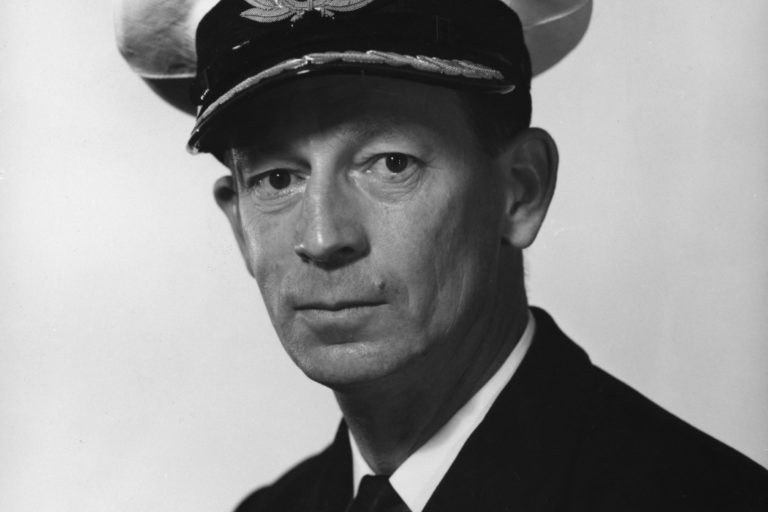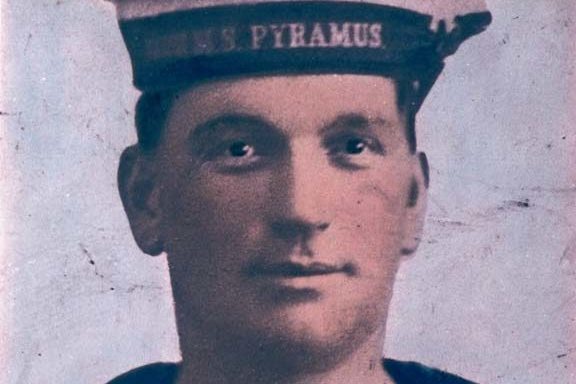In June 1956 the New Zealand government purchased this vessel for £20,000 and it was sent for refitting. It was decided that this vessel would carry the name Endeavour. Endeavour was commissioned to transport the New Zealand section of the Commonwealth Trans-Antarctic Expedition which included Edmund Hilary. The destination was McMurdo Sound.
Ship Details: [1]
Class: Ailanthus-class wooden hull netlayer
Displacement: 1190 tonnes
Dimension: 59.3 x 52.4 x 10.5x 4.1m
Machinery: 1-shaft diesel-electric shp-1200 = 13knots
Armament: not armed in RNZN service – was fitted originally with 1 x 76mm, 2x20mm guns
Complement: 34 plus 18 passengers
Built: American Car & Foundry Co. Wilmington
Laid Down: 1 May 1943
Launched: 25 May 1944
Completed: 5 August 1944
Commissioned as: HMS Pretext
Pennant No. Z284 – Royal Navy no pennant number issued for RNZN service
Ship’s Badge:[2]
Battle Honours: Cadiz 1596
Motto: Nil Intentatum (Nothing unattempted)
The ship’s badge was designed by RM Major Charles ffoulkes for a RBN survey ship that carried this name when ship’s badges were first introduced in 1918. HMNZS Endeavour carried the RN design of a diamond shaped badge approved in 1919 as its ship’s badge while in RNZN service. The badge celebrates Captain James Cook and his ship Endeavour who charted New Zealand in 1769. The design incorporates elements from a medal struck to commemorate Cook’s discovery. The motto is taken from that of Captain Cook. The badge design above was issued in 1988 with the commissioning of the third ship to carry the name Endeavour. The name comes from the barque commanded by Cook in his first voyage 1969-1771.
Ship’s History:[3]
This vessel was one of forty wooden-hut netlayers that were built for the United States Navy of which twenty were ordered for the Royal Navy under the lend-lease programme. This ship’s designated name was USS YN89 but in January 1944 it was reclassified as AN76 and given the name USS Satinwood. The ship was one of five that were delivered to the Royal Navy and was to be named HMS Protect. Upon being handed over in August 1944 she was named Pretext. She served at Rosyth as part of the boom defences until February 1945 then was sent to Portsmouth. She was returned to the United States Navy on 29 November 1945.
In July 1947 she was sold to the Falkland Islands as the request of the Colonial Office. She was sent to Britain in October 1947. She was refitted and converted for use as a supply, survey and research ship to be based at Port Stanley. In December 1947 she was renamed John Briscoe after an Antarctic sealing skipper of the nineteenth century. The conversion was completed in November 1948 including ice-strengthening by way of greenheart sheathing 76mm thick. The stem was solid steel. She served until June 1956 in the Falklands. In April 1956 the name was again changed back to Pretext to free the name for a new vessel to be named John Briscoe.
RNZN Service:[4]
In June 1956 the New Zealand government purchased Pretext for £20,000 and was sent for refitting. It was decided that this vessel would carry the name Endeavour which meant a small yard auxiliary was renamed Hauraki. She was refitted at Northam by John I. Thornycroft & Co. and commissioned into service with the RNZN on 15 August 1956. Endeavour departed Britain on 23 August 1956 and arrived in Auckland on 20 October.
Endeavour was commissioned to transport the New Zealand section of the Commonwealth Trans-Antarctic Expedition which included Edmund Hilary. The destination was McMurdo Sound. Endeavour departed Bluff on 21 December 1956 and remained in the Antarctic until she returned to Auckland in March 1957. The first commanding officer was Captain Kirkwood RN who had been seconded to the RNZN because of his ice experience. He had been commanding officer of John Biscoe and when in command had circumnavigated the Antarctic from the John Biscoe. He was described by the ship’s company as a bit pucker sort of RN type, but was quite a character underneath.
Endeavour was heavily loaded during the 1956 trip. It carried on deck a Beaver aircraft in a large crate alongside an Auster floatplane. The Beaver was left behind when the ship departed for New Zealand. The planes were parked on the ice, just below a big ice cliff on Pram Point, which gave them shelter. The Auster is now on display at the RNZAF Museum at Wigram. The expedition also loaded Massey tractors with tracks for carrying out the expedition. Finally, the ship carried three husky teams with pups that proved great entertainment for the ship’s company. A storm smashed up some of the kennels and the dogs had to be tethered on deck. The dogs were pretty miserable “[because] they didn’t like the damp anyway.”[5] Despite having the Massey tractors, there were still places that only the dog-sleds could get to. Endeavour carried 44 gallon drums of aviation fuel for the aircraft. The Beaver was unloaded on 14 January and was assembled by RNZAF personnel. The first flight was made the next day to Butter Point to pick up the husky teams.
After the dogs, aircraft, tractors and the gear hand been unloaded expedition team got their initial survey party together, to work out a path across the ice to Butter Point to where they were going to set up an operating base which was the main task for the expedition. Initially it was going to be located at Butter Point but it was inaccessible. The United States Navy lent a helicopter to find a more suitable site. Five kilometres around from Cape Armitage, behind the American base the expedition team selected a new site. It would be named Scott Base after Captain Robert Flacon Scott, the tragic figure of Antarctic exploration. Hilary approached Captain Kirkwood to get assistance from the ship’s company. It was decided that half would go up and spend a few days working on the base and the other half would stand by the ship, because the ship had to always be in a position to be able to steam clear of the ice. Men would swap over every three or four days. Due to the permanent sunlight, men work on average fourteen hour days. The ship’s company assisted because the expedition team were very busy with their own tasks.
On January 1957 the first hut [‘A’ Hut] was completed and the official opening of Scott Base was celebrated. The flag pole from Scott’s hut at Cape Evans was recovered and erected at Scott Base. The ship’s company participated in the official ceremony along with personal from the American Base and the United States Navy. It was critical that the base be weather proofed before the Endeavour had to depart. In the week leading up to 22 February was hectic as the ship’s company got Endeavour ready to return to New Zealand and the party that was up at Scott Base was working very hard to get the huts closed in completely and complete the tunnel system between the huts, so that access to the huts was possible regardless of the weather. This was achieved before Endeavour left.
In addition the Hut Point Chapel [aka Chapel of the Snows] this was not on the original plans for the American McMurdo base. Somehow, material was gathered by the personnel and a non-denominational chapel was built in 1957. It was located on a knoll overlooking the base and remained there until a fire in 1978 destroyed it. It was rebuilt and is still in use today.
During the time in Antarctica parties visited Cape Royds and Cape Evans including Shackleton’s and Scott’s huts. Men hunted seals to feed the husky teams. Two Yog-class small tankers belonging to the United States Navy were inspected. They were held fast by the ice, right alongside Hut Point and used purely as static tankers with no sailors on board.
Endeavour returned to Antarctica in December 1957 and carried out further construction on Scott Base. In March 1958 she returned to Auckland carrying the personnel, tractors and aircraft of the British and New Zealand expedition. She then returned to the ice from December to March in 1958-1960. While in she was operating in Antarctica, the American icebreakers assigned to Operation DEEP FREEZE assisted Endeavour reaching McMurdo Sound. By 1960 there were concerns about the sheathing and caulking of her hull and it was deemed that the 1960-1961 season would be her last deployment. She left McMurdo Sound for the last time on 22 February 1961 and arrived in Auckland on 2 March for an essentials-only refit.
Antarctic service was not her only duty. Endeavour when in New Zealand waters would undertake a variety of tasks including transporting ammunition and dumping old stocks for all three services. She also carried out oceanographic research work. When engaged in these two tasks, Endeavour would be rigged with a foresail and mizzen to steady the ship. She also ran supplies to the meteorological stations on Campbell and Raoul Islands and supply duties to some Pacific islands.
Disposal
Endeavour arrived in Auckland for paying off on 7 November 1961. In June 1962 she was sold to Shaw Steam Ship Co. in Canada. She was handed over in September and renamed Arctic Endeavour. She was used for sealing in the Arctic until the 1980s when she sank at her moorings in November 1982 and was broken up in 1983.
[1] R.J. McDougall, New Zealand Naval Vessels, Christchurch: GP Books, 1989, p. 111.
[2] P.Y. Dennerly, P.Y., Ships Badges of the Royal New Zealand Navy, Auckland: Royal New Zealand Navy Museum, 1997, p. 18.
[3] R.J. McDougall, New Zealand Naval Vessels, Christchurch: GP Books, 1989, pp. 111-112.
[4] R.J. McDougall, New Zealand Naval Vessels, Christchurch: GP Books, 1989, p. 112.
[5] Captions for Rogers Antarctic images 2007 exhibition.









